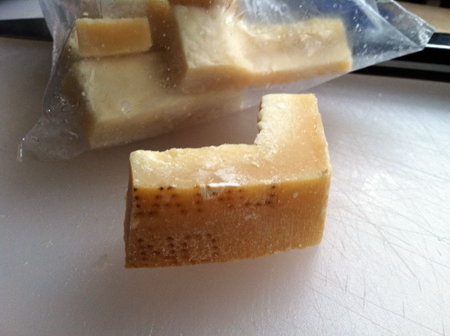
It’s Tuesday, and I’ve got a quick kitchen tip to share with you. Which means I’m hereby christening today Quick Tip Tuesday. Should I happen to have another quick kitchen tip for you, and should it happen to fall on a Monday, well, I guess I’ll have to hold it back for a day. Rules is rules.
So, let’s talk Parmesan rinds. You’re grating your own cheese, right? Parmigiano Reggiano, the aged, crumbly-salty-crunchy cheese that is (literally) the only type I’ll eat out of hand, is a luxury item that’s totally, 100%, unquestionably worth it. I even wrote about it for Weight Watchers! But when you buy a hunk of the good stuff, it always comes with a section of the rind attached, with at least a portion of the words “Parmigiano Reggiano” visible—this proves that it really is Reggiano, since use of the name is strictly regulated by the Italian authorities.
When you’re paying $15 a pound for a hunk of cheese, you sure as heck don’t want to waste any of it. But that hard rind is inedible as-is, so it’s tempting to just toss it. Don’t! Instead, stick it in the freezer, and next time you make soup, sauce, or some other long-simmering recipe that includes ample liquid, toss it in, still frozen. The heat of the cooking food will soften the rind and release umami—an intoxicating, nearly indescribable savoriness—into the dish. Or go whole hog and made Cheese Broth, using nothing more than rinds and cold water, as described in The Frankies Spuntino Kitchen Companion & Cooking Manual.
The best part: After a long, hot bath, that hard, inedible rind becomes soft enough to spread on bread and eat! Zero waste, and huge taste.
To get you started, here are some recipes from Words to Eat By that use Parm rind:
- Roasted Vegetable Barley Soup
- Clean-Out-the-Fridge Lentil Soup with Turkey Meatballs
- Farro & White Bean Soup with Escarole
What’s your favorite kitchen tip? And what kind of tips are you looking for?
